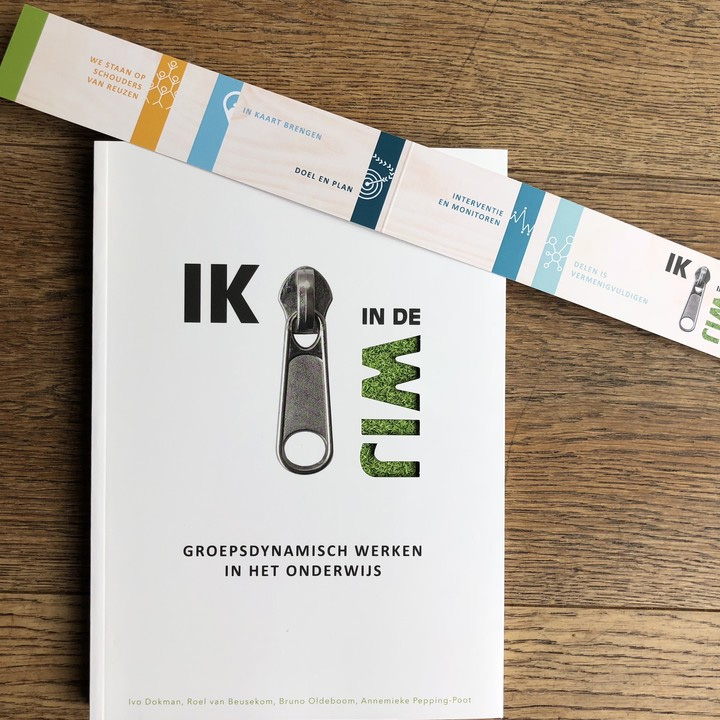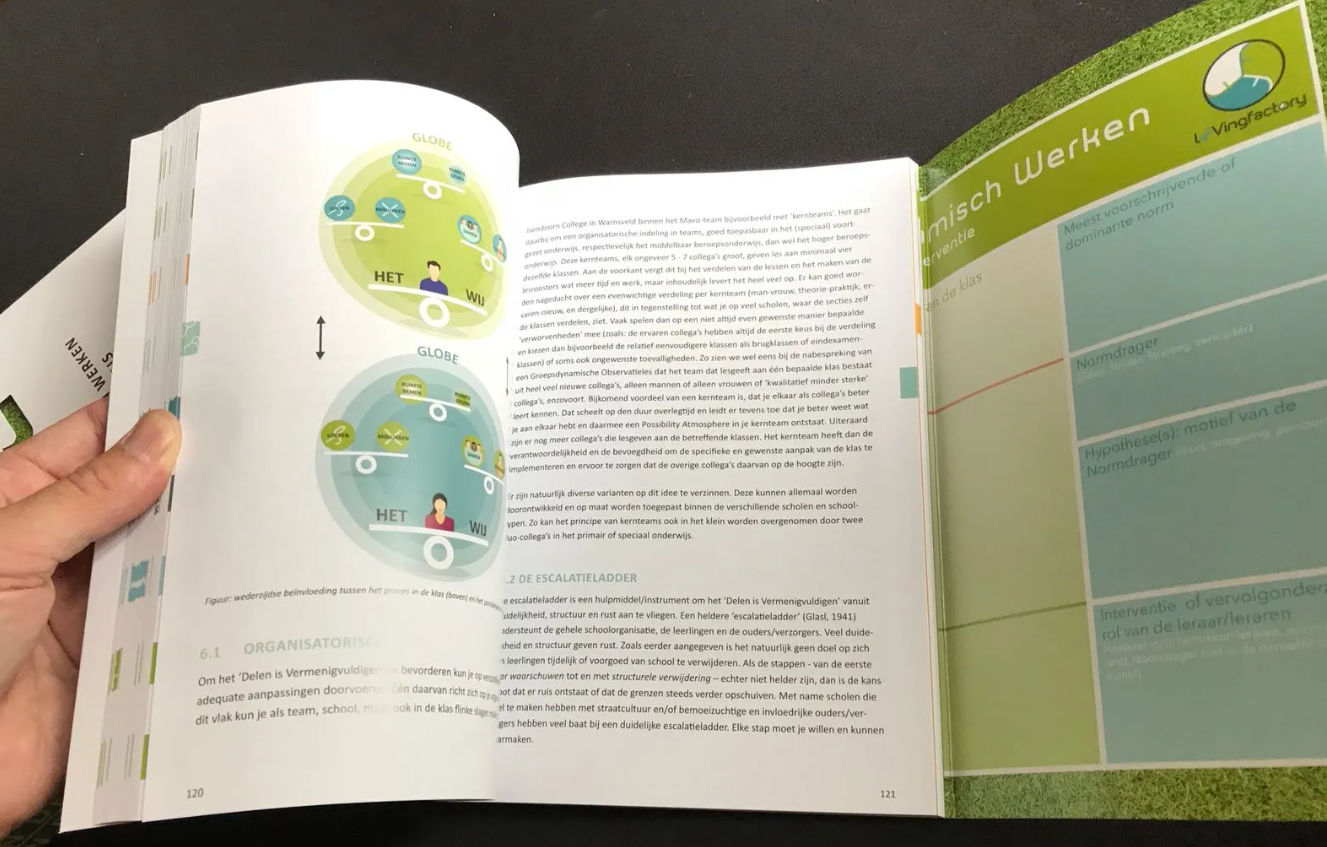Bronnen
Aaker, J. L., & Williams, P. (1998). Empathy versus pride: The influence of emotional appeals across cultures. Journal of consumer research, 25(3), 241-261.
Alblas, G. & Vos, W. (2014). Inleiding groepsdynamica. Groningen: Noordhoff Uitgevers.
Asch, S. E. (1956). Studies of independence and conformity: I. A minority of one against a unanimous
majority. Psychological Monographs: General And Applied, 70(9), 1-70.
Belbin, M. R. (1981) Management teams. Over succes- en faalfactoren voor teams. Den Haag: Academic Services.
Bem, D. J. (1972). Self-Perception Theory. In L. Berkowitz (Ed.). Advances in Experimental Social Psychology (Vol. 6, pp.1-62). New York: Academic Press.
Benne, K. D. & Sheats, P. (1948). Functional roles of group members. Journal of social issues, 4(2), 41-49.
Biesta, G., & Pols, W. (2012). Goed onderwijs en de cultuur van het meten. Amsterdam: Boom Lemma.
Boostrom, R. (1991). The nature and functions of classroom rules. Curriculum Inquiry, 21(2), 193-216.
Bregman, R. (9 december 2016). De echte les van het beruchte Stanford Prison Experiment: vertrouwen is sterker dan haat. www.decorrespondent.nl.
Cialdini, R. B. (2009). Invloed-De zes geheimen. Academic Service, Amsterdam, the Netherlands.
Cialdini, R. B., & Trost, M. R. (1998). Social influence: Social norms, conformity and compliance. In D. T. Gilbert, S. T.
Fiske, & G. Lindzey (Eds.), The handbook of social psychology (pp. 151-192). New York, NY, US: McGraw-Hill.
Collot d’Escury-Koenigs, A. L., Beusekom, R., Dokman, I. (2014 en 2015). Klasse(n)spel en passend onderwijs . Lichamelijke Opvoeding.
Kok, B. E., & Fredrickson, B. L. (2010). Upward spirals of the heart: Autonomic flexibility, as indexed by vagal tone, reciprocally and prospectively predicts positive emotions and social connectedness. Biological psychology, 85, 432-436.
Kunneman, H. (2015). Voorbij het dikke-ik. Bouwstenen voor een kritisch humanisme. Amsterdam: SWP Uitgeverij
Larson, C. E., & LaFasto, F. J. (1989). Teamwork: What must go right/what can go wrong. Thousand Oaks, CA, US: Sage Publications, Inc
Leary, T. (1958). Interpersonal diagnosis of personality. American Journal of Physical Medicine & Rehabilitation, 37(6), 331.
Lyubomirsky, S., King, L., & Diener, E. (2005). The benefits of frequent positive affect: Does happiness lead to success? Psychological Bulletin, 131, 803-855.
Mainhard, M. T., Brekelmans, M., Wubbels, T., & den Brok, P. (2008). Leraren in een nieuwe klas: De eerste maanden van een nieuw schooljaar. Pedagogische Studiën, 85(3), 157-173.
Mayer, R.C., Davis J.H., Schoorman F.D. (1995). An integrative model of organizational trust. Academy of Management Review. 20 (3), 709-734.
McEwen, B. S., & Gianaros, P. J. (2010). Central role of the brain in stress and adaptation: links to socioeconomic status, health, and disease. Annals of the New York Academy of Sciences. 1186, 190-222.
Milgram, S. (1963): Behavioral study of obedience. Journal of Abnormal and Social Psychology, nr. 4, 371-378.
Noordman, W.., Leenders, R. Beusekom, R., Dokman, I. (2010). Beïnvloeding van gedrag; een Klasse(n)spel. Lichamelijke Opvoeding. 7,8,9, 10.
Oldeboom, B. Fokkens-Bruinsma, M. F. & Van Veen, K. (in voorbereiding). Conceptualisering van klassenmanagement.
Oveis, C., Cohen, A. B., Gruber, J., Shiota, M. N., Haidt, J., & Keltner D. (2009). Resting respiratory sinus arrhythmia is associated with tonic positive emotionality. Emotion, 9, 265-270.
Pavani, J. B., Le Vigouroux, S., Kop, J. L., Congard, A., & Dauvier, B. (2016). Affect and affect regulation strategies reciprocally influence each other in daily life: The case of positive reappraisal, problem-focused coping, appreciation and rumination. Journal of Happiness Studies, 17, 2077-2095.
Prescott, C. (28 april, 2005). The lie of the Stanford Prison Experiment. The Stanford daily Volume 227, Issue 50.
Remmerswaal, J. (2013). Handboek Groepsdynamica. Amsterdam: Boom Nelissen.
Roeser, R. W., Schonert-Reichl, K. A., Jha, A., Cullen, M., Wallace, L., Wilensky, R. & Harrison, J. (2013). Mindfulness training and reductions in teacher stress and burnout: Results from two randomized, waitlist-control field trials. Journal of Educational Psychology, 105, 787-804.
Sawyer, K. (2007). Group genius. The Creative Power of Collaboration. New York: Perseus Books.
Simons, R.J. (2001). Van opleiden naar Human Resource Development. Simons, P. R. J. (2001). In Kessels, J., & Poell, R. F. (2011). Handboek human resource development. Organiseren van het leren. Handbook Human Resource Development. The organization of learning. Houten: Samsom. 213-228.
Sloter, M. (2017). De zes rollen van de leraar. Handboek voor effectief lesgeven. Huizen: Uitgeverij Pica.
Sommer, R. (1959). Studies in personal space. Sociometry, (22) 247-260.
Stevens, L. (2004). Zin in School. Utrecht: EDG. Media uitgeverij.
Cohn, R. C. (1983). Van psycho-analyse naar themagecentreerde interactie, bouwstenen voor een pedagogisch systeem voor onderwijs, vorming en hulpverlening. Baarn: Nelissen.
Damasio, A. (2010). Self comes to mind: Constructing the conscious brain. New York, NY, US: Pantheon/Random House.
Davey, C. G., López-Solà, C., Bui, M., Hopper, J. L., Pantelis, C., Fontenelle, L. F., & Harrison, B. J. (2016). The effects of stress–tension on depression and anxiety symptoms: evidence from a novel twin modelling analysis. Psychological Medicine, 46, 3213-3218.
De Jong, C. A. J., Brink, W., & Jansma, A. (2000). ICL-R: Handleiding bij de vernieuwde Nederlandse versie van de Interpersonal Checklist (ICL).
Deci, E.L., & Ryan, R.M. (1985) Intrinsic motivation and self-determination in human behavior. New York: Plenum. Doyle, W. (2006). Ecological approaches to classroom management. In C. M. Evertson, C. S. Weinstein, C. M. Evertson,
C. S. Weinstein (Eds.), Handbook of classroom management: Research, practice, and contemporary issues (pp. 97-125). Mahwah, NJ, US: Lawrence Erlbaum Associates Publishers.
Dutton, K. (2010). Flipnosis. Doortastend optreden in extreme situaties. Amsterdam: De bezige bij.
Fraser, B. J. (1991). Two decades of classroom environment research. In B. J. Fraser, H. J. Walberg, B. J. Fraser, H. J.
Walberg (Eds.), Educational environments: Evaluation, antecedents and consequences (pp. 3-27). Elmsford, NY, US: Pergamon Press.
Fredrickson, B. (2009). Positivity: Top-notch research reveals the 3 to 1 ratio that will change your life. Random House Digital, Inc.
Glasl, F. (1982). The Process of Escalation and Roles of Third Parties. Conflict Management and Industrial Relations. G. B. J. Bomers and R. B. Peterson. Boston, MA, Kluwer-Nijhoff Publishing: 119-140.
Golding, W. (1954). Lord of the flies. London: Faber & Faber.
Groves, P. M., & Thompson, R. F. (1970). Habituation: A dual-process theory. Psychological Review, 77(5), 419-450.
Hadioui, I.E. (2011) Hoe de straat de school binnendringt. Denken vanuit de pedagogische driehoek van de thuiscultuur, de schoolcultuur en de straatcultuur. Amsterdam: Van Gennep Uitgeverij.
Hall, E. T. (1966). The hidden dimension. New York, NY, US: Doubleday & Co
Haney, C., Banks, C., & Zimbardo, P. (1973). Interpersonal dynamics in a simulated prison. International Journal Of Criminology & Penology, 1(1), 69-97.
Janis I. L. (1972). Victims of groupthink; a psychological study of foreign-policy decisions and fiascoes. Boston: Houghton, Mifflin.
Johnson, D.W. & Johnson, F., (2015). Groepsdynamica, theorie en vaardigheden. Amsterdam. Pearson Benelux
Kok, B. E., & Fredrickson, B. L. (2010). Upward spirals of the heart: Autonomic flexibility, as indexed by vagal tone, reciprocally and prospectively predicts positive emotions and social connectedness. Biological psychology, 85, 432-436.
Kunneman, H. (2015). Voorbij het dikke-ik. Bouwstenen voor een kritisch humanisme. Amsterdam: SWP Uitgeverij
Larson, C. E., & LaFasto, F. J. (1989). Teamwork: What must go right/what can go wrong. Thousand Oaks, CA, US: Sage Publications, Inc
Leary, T. (1958). Interpersonal diagnosis of personality. American Journal of Physical Medicine & Rehabilitation, 37(6), 331.
Lyubomirsky, S., King, L., & Diener, E. (2005). The benefits of frequent positive affect: Does happiness lead to success? Psychological Bulletin, 131, 803-855.
Mainhard, M. T., Brekelmans, M., Wubbels, T., & den Brok, P. (2008). Leraren in een nieuwe klas: De eerste maanden van een nieuw schooljaar. Pedagogische Studiën, 85(3), 157-173.
Mayer, R.C., Davis J.H., Schoorman F.D. (1995). An integrative model of organizational trust. Academy of Management Review. 20 (3), 709-734.
McEwen, B. S., & Gianaros, P. J. (2010). Central role of the brain in stress and adaptation: links to socioeconomic status, health, and disease. Annals of the New York Academy of Sciences. 1186, 190-222.
Milgram, S. (1963): Behavioral study of obedience. Journal of Abnormal and Social Psychology, nr. 4, 371-378.
Noordman, W.., Leenders, R. Beusekom, R., Dokman, I. (2010). Beïnvloeding van gedrag; een Klasse(n)spel. Lichamelijke Opvoeding. 7,8,9, 10.
Oldeboom, B. Fokkens-Bruinsma, M. F. & Van Veen, K. (in voorbereiding). Conceptualisering van klassenmanagement.
Oveis, C., Cohen, A. B., Gruber, J., Shiota, M. N., Haidt, J., & Keltner D. (2009). Resting respiratory sinus arrhythmia is associated with tonic positive emotionality. Emotion, 9, 265-270.
Pavani, J. B., Le Vigouroux, S., Kop, J. L., Congard, A., & Dauvier, B. (2016). Affect and affect regulation strategies reciprocally influence each other in daily life: The case of positive reappraisal, problem-focused coping, appreciation and rumination. Journal of Happiness Studies, 17, 2077-2095.
Prescott, C. (28 april, 2005). The lie of the Stanford Prison Experiment. The Stanford daily Volume 227, Issue 50.
Remmerswaal, J. (2013). Handboek Groepsdynamica. Amsterdam: Boom Nelissen.
Roeser, R. W., Schonert-Reichl, K. A., Jha, A., Cullen, M., Wallace, L., Wilensky, R. & Harrison, J. (2013). Mindfulness training and reductions in teacher stress and burnout: Results from two randomized, waitlist-control field trials. Journal of Educational Psychology, 105, 787-804.
Sawyer, K. (2007). Group genius. The Creative Power of Collaboration. New York: Perseus Books.
Simons, R.J. (2001). Van opleiden naar Human Resource Development. Simons, P. R. J. (2001). In Kessels, J., & Poell, R. F. (2011). Handboek human resource development. Organiseren van het leren. Handbook Human Resource Development. The organization of learning. Houten: Samsom. 213-228.
Sloter, M. (2017). De zes rollen van de leraar. Handboek voor effectief lesgeven. Huizen: Uitgeverij Pica.
Sommer, R. (1959). Studies in personal space. Sociometry, (22) 247-260.
Stevens, L. (2004). Zin in School. Utrecht: EDG. Media uitgeverij.
Stevens, L.& Bors, G. (2013). Pedagogische tact. Op het goede moment het juiste doen, ook in de ogen van de leerling. Apeldoorn: Garant Maklu.
Teitler, P. (2013). Lessen in orde. Handboek voor de onderwijspraktijk. Bussum: Coutinho.
Trickett, E. J., & Moos, R. H. (1973). Social Environment of Junior High and High School Classrooms. Journal Of Educational Psychology, 65, 1, 93-102.
Tuckman, B. W. (1965). Developmental sequence in small groups. Psychological Bulletin, 63(6), 384-399.
Van den Berg, B. (2009). Net het echte leven. Belangen, macht en illusies in professionele teams. Leiden: Sidestone Press. Van Es, R. (2008). Veranderdiagnose. De onderstroom van organiseren. Deventer: Vakmedianet.
Van Tartwijk, J. W. F., Brekelmans, M., den Brok, P. J., & Mainhard, M. T. (2014). Theorie en praktijk van leren en de leraar: liber amicorum Theo Wubbels. Uitgeverij SWP.
Van Zundert, R. M. P. (2017). Heleschoolbenadering Positieve Psychologie. Tijdschrift voor Positieve Psychologie, 1, 72-80.
Van Zundert, R. M. P. (in druk). Welbevinden. Wat is het en wat heb je nodig om het (optimaal) te ontwikkelen? Uitgeverij SWP: Amsterdam.
Verhaeghe, P. (2015). Autoriteit. Amsterdam: De Bezige Bij.
Verhaeghe, P. (2012). Identiteit. Amsterdam: De Bezige Bij.
Vliek, L. (2015). Effects of Kanjertraining (Topper Training) on Emotional Problems, Behavioural Problems and Classroom Climate. Dissertatie. Universiteit Utrecht.
Watzlawick, P., Beavin, J.H. & Jackson, D.D. (2012). De pragmatische aspecten van de menselijke communicatie. Houten: Bohn Stafleu van Loghum.
Wheelan, S. A. (2009). Group size, group development, and group productivity. Small Group Research, 40(2), 247-262.
Wilson, J. Q, Kelling, G. L (Maart 1982). Broken Windows: The police and neighborhood safety,The Atlantic.






0 reacties